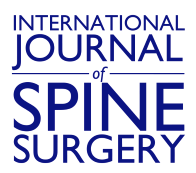
Abstract
BACKGROUND CONTEXT: Anterior cervical discectomy and fusion (ACDF) surgery is a standard surgical procedure in the management of intractable radiculo-myelopathy as a result of surgical degenerative disc disease. The procedure has been shown to provide satisfactory relief from symptoms and improve neurologic functions in the patients for both short and long term follow-up periods. Most of the published studies however are either retrospective or single-arm prospective trials with a bias for patient selection, expectancy and/or proficiency. Additionally, no prospective study has compared the clinical outcomes of the anterior cervical fusion procedure based upon the initial number of levels operated.
PURPOSE: This study analyzes the clinical and radiological data from the control (ACDF) group of patients in the IDE trial to assess and compare the outcomes for the fusion procedure at 24 months.
STUDY DESIGN/SETTING: The IDE trial for the Mobi-C© artificial cervical disc was conducted at 24 centers in the US and has completed the protocol required 24-months follow-up data collection. The trial was enrolled for single and two-level cervical disc disease and the control arm consisted of anterior cervical fusion with allograft bone and plating at one or two contiguous levels of cervical spine.
PATIENT SAMPLE: Five hundred and twenty-five patients were enrolled in the trial. Since the randomization scheme was 2:1 (TDR:ACDF), 186 patients received ACDF as the control group. 81 patients had single level and 105 had two-level fusion procedures.
OUTCOME MEASURES: Outcome measures collected were NDI, VAS neck and arm pain, adverse events (deemed major complications), re-operation rate, and neurologic examinations of sensory, motor and reflex function.
METHODS: Whether an adverse event was deemed a major complication was determined by a committee of three independent surgeons. Any worsening of sensory, motor, or reflex function from the baseline was considered neurologic deterioration. Reoperation rates include any additional surgery that involved the originally implanted device and/or any surgery intended to treat the original indications at the index level.
RESULTS: Mean NDI and VAS neck pain scores were similar for patients in both groups (1L and 3L treatment) at both preoperative baseline and 24 months postoperatively, indicating that both procedures result in improvements in neck function and reduction in pain. However, the rate of occurrence of adverse events that were assessed to be major complications was higher after 2-level procedures (2.5% vs 5.7%) and the incidence of neurologic deterioration from the baseline of 24 months was higher after 2-level procedures (2.5% vs 5.7%). The re-operation rate after 2-level procedures was 11.4% compared to 6.2% after 1-level procedures.
To Read The Full Article Click Here





